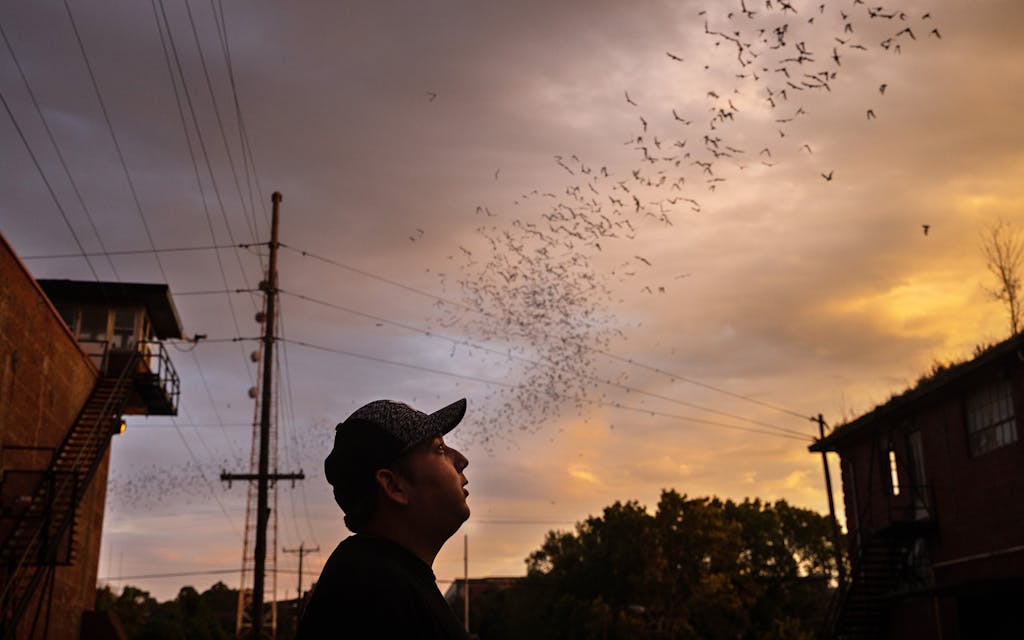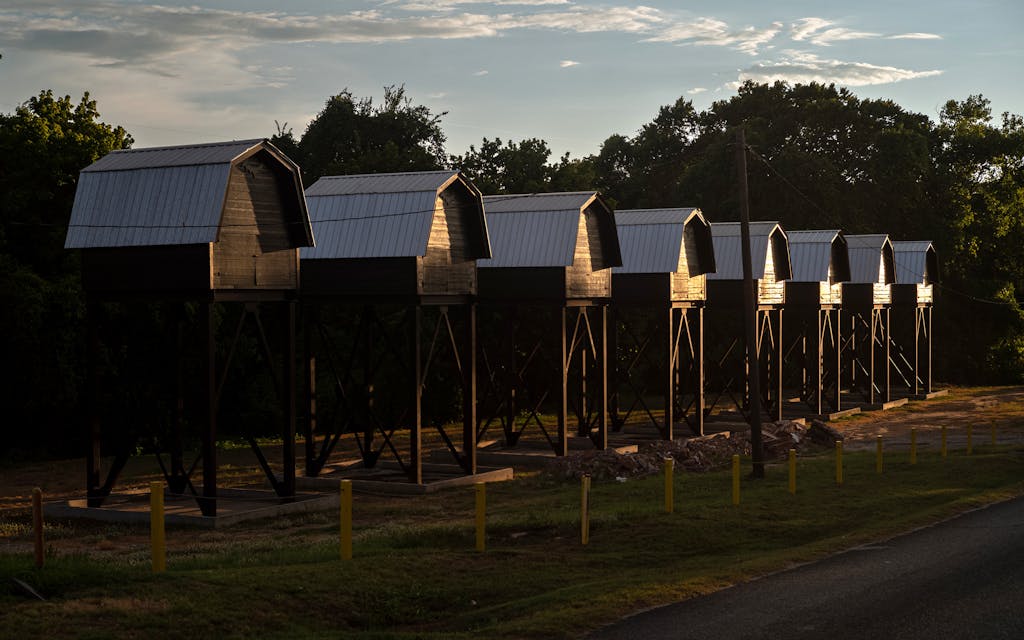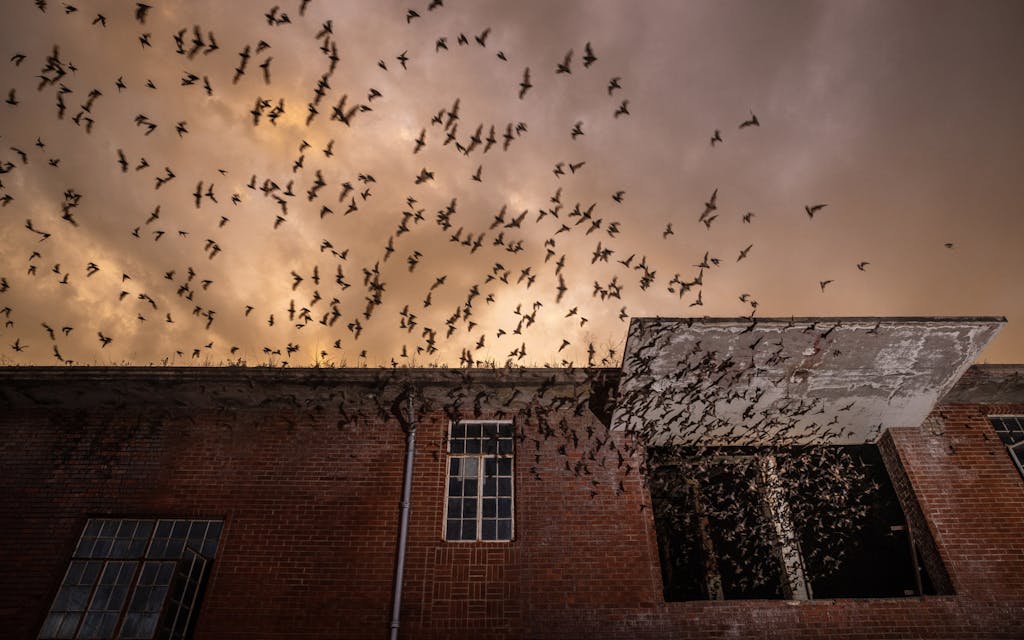Many a tourist attraction fails to live up to the hype surrounding it, but that is never the case when bats are involved. Stand in the crowd at one of Austin or Houston’s bat-friendly bridges, or park a camping chair outside of Comal County’s Bracken Cave—the summer home of an estimated 20 million Mexican free-tailed bats and the largest bat colony in the world—and you will be awed as the winged critters take to the skies for their nighttime hunt. They pour out of their roosts with such grandeur, the actual scientific term for the event is “the emergence.” They appear not as a collection of individual creatures—with those leathery wings, hooked thumbs, and adorably big ears—but as a cohesive mass, like a plume of smoke or an expensive, complicated visual effect out of a Marvel movie. The experience is even more surreal if it occurs right next door to the most infamous prison in the state.
The beauty of an emergence is one reason the citizens of Huntsville are trying hard to save the bat colony currently roosting in an abandoned building next door to the Walls Unit, the Texas State Penitentiary right in the middle of town. The city block–long warehouse, originally built in the 1930s to house cotton and other dry goods produced by prisoners, is a decrepit carcass of a building, with dead trees rising out of its crumbling roof. It would be an eyesore were it not for the 750,000-plus Mexican free-tailed bats spending their summers there, who stream out of the broken windows every night around eight. The bats attract locals and tourists to downtown Huntsville, where spectators park their cars next to the fifteen-foot-tall red brick barricades that give the Walls Unit its name. As the bats emerge, the hum of hundreds of thousands of flapping wings mingles with the roar of the siren indicating it’s time to count the prisoners. Families set up camping chairs so they may be awed by the majesty of the natural world a stone’s throw from the building where the state conducts all of its executions. It is a strange pairing—nature’s majesty hand in hand with depravity of man—and it could all go away if the Texas Department of Criminal Justice ever gets to tear that warehouse down, which it has been wanting to do for well over a decade.

The TDCJ has long said the warehouse is hazardous and that it must be safely demolished before it falls apart on its own. Phase one of demolition has already begun; in March of this year, construction workers knocked down the northernmost third of the warehouse before pausing in the spring when the bats returned from their annual migration. They intended to finish demolition once the bats left again in the fall. What the TDCJ may not have anticipated is the growing number of impassioned locals working hard to keep that from happening.
“I’ve lived around this area all my life, and I’ve never seen anything in our town draw people together quite like this issue,” says Tommy Hoke, one of the locals leading the charge. Hoke, an engineer who also does service work at the Baptist church next to the warehouse, was always aware of the bats, but he only became a self-described bat nerd when he saw demolition on the warehouse had begun. The more Hoke read about the bats—like how their insect-focused diet saves Walker County farmers an estimated $3 million in annual pesticide costs (because they eat a helluva lotta bugs)—the more certain he was about their value to the community, and the more concerned he was about their future. “But I was apprehensive. I’m just a regular guy; I’m not a biologist. What can I do?” He took his concerns to Facebook, starting a page called Help! Save The Bats in Huntsville!! His first post was shared over nine hundred times, and his group is currently the largest of the two pro-bat Facebook groups in town, with over 1,600 members.


At the same time, Huntsville City Council member Daiquiri Beebe was also rallying to the cause. She formed the other Facebook group, the Huntsville Bat Society, which now has over 1,300 members, and started a Change.org petition to let the prison know some citizens of Huntsville wanted the bats to stay. Beebe tried to get the city council to pass a resolution officially opposing the TDCJ’s plans, and when it didn’t land the votes needed, she kept at it, planning pro-bat happy hours and protests at Huntsville City Hall.
The cause is catching on. When I went to the bat emergence one evening in late July, there were a dozen or so Huntsville residents there, some of whom were watching the bats for the first time, having learned about them specifically from Hoke’s and Beebe’s efforts on Facebook. As members of the public grew more vocal in favor of the bats, Beebe was able to enlist other local government officials to the cause. She teamed up with state representative Ernest Bailes and the county commissioners’ court, who also wanted the prison to halt demolition. Members of the city council who had voted against Beebe’s earlier resolution even started to come around. “We had the public, the city council, and the county commissioners all saying, ‘We have to stop this; we can’t let them tear the warehouse down,’ ” Beebe recalls. Their powers combined, this informal coalition took their concerns to the prison, and in mid-July they were able to get the TDCJ to agree to halt demolition until at least 2024.
TDCJ has been trying to solve its bat problem for years. It’s a tricky issue. Mexican free-tailed bats, our state’s official flying mammal (a helluva category) are protected by law. Though the warehouse is on TDCJ property, Texas Parks and Wildlife can stop TDCJ from tearing it down, lest it result in unnecessary loss of bat life, and did so when prison officials first tried to demolish the building in 2012. Years later, the prison took note of University of Florida’s success in expelling bats from its football stadium, an effort spearheaded by Merlin Tuttle, an Austin conservationist known as Texas’s “Bat Man.” TDCJ had Huntsville inmates construct artificial bat roosts, or “bat hotels,” meant to lure the colony out of the warehouse over a period of years. But for reasons known only to the TDCJ, the expert-provided blueprints weren’t properly followed, resulting in too-tall, painted black bat houses. In the five years since they were erected next to the warehouse, the structures that Hoke and others refer to as “bat ovens” have attracted zero bats.

Via spokespeople, both the Texas Department of Criminal Justice and Texas Parks and Wildlife insist that the decision to begin demolition earlier this year was not made lightly. The hope was that by tearing down the building in stages, the bats would be encouraged to finally move to the artificial roosts, a plan a TDCJ representative says is “based on recommendations from experts in the field.” The agency has only now agreed to pause that plan “to ensure community members and advocates are engaged in the discussion,” unwilling to admit it may have been a flawed plan to begin with. (There is a rumor that the prison tried to board up the warehouse one night when the bats were out, in an effort to get them to go in the bat hotels, but all that ended up happening is that the bats went to the warden’s house down the street and crapped all over his cars. A prison representative says this did not happen.) If something were to happen to the warehouse, either by planned demolition or disaster, it could be calamitous for the community. If the bats were to return from their migration in springtime and find no home, they would likely roost under nearby roof shingles and carports, or in stadiums across town. This would lead to an increase in interactions between humans and bats, who can bite when provoked.
Now that the TDCJ has paused demolition and given conservationists a bit more time, the real work begins. The building is still decrepit, which means even if the TDCJ agrees to never knock it down, there’s little guarantee it won’t demolish itself. This structural instability has created urgency, though any effort to move the bats will take years. Russell Humphrey, a city council member who jokes that he’s become a “batologist” in the past few months (the correct term for someone who studies bats is “chiropterologist”), likened the bat issue to “a hurricane coming straight toward Huntsville.” Even with the delay, he’s worried. “We’ve got twelve months or so to come up with a miracle bullet to take care of this thing, and I don’t think that’s realistic.” Humphrey is on the TDCJ-led steering committee, which the department set up when the pro-bat Facebook groups started growing. The steering committee has representatives from the prison, the city, and Texas Parks and Wildlife, though its effectiveness is up for debate. Daiquiri Beebe describes it as “basically a PR committee.”
Nathan Fuller, a chiropterologist with TPWD, is working with the TDCJ and stressed to me that he believes the prison officials are “operating in good faith,” but there’s never been a conservation problem quite like this before. “We are not following a precedent at all,” he says. “This is the largest bat colony that I can think of that is in an urban center, in a building that’s right in the middle of everything. The bridges [in Austin and Houston] are different stories, because the bats are removed from people, over the tops of rivers. This is a building that’s right across the street from local businesses, churches, and day cares.”
There are a number of paths forward. Daiquiri Beebe says there is a group currently organizing a nonprofit that could take control of the warehouse and raise funds for its repair. She sees the bats as a huge opportunity for Huntsville tourism, saying that a small bat stuffed animal is already the most popular item at the gift shop by the city’s biggest attraction: the 67-foot-tall Sam Houston statue on Interstate 45. But even a restored building may not work as a long-term solution. What happens if the colony continues to grow? Fuller says that the warehouse isn’t currently at maximum capacity, but it will get there eventually, and then the bats will be even harder to move. And how sustainable is it to have a major tourist attraction next door to a prison, where there are executions and the protests that accompany them?
Tommy Hoke, the founder of the original bat-friendly Facebook group, who says seeing Merlin Tuttle’s name pop up on his caller ID was akin to “what my teenage daughters would be like if Conan Gray called,” believes he’s found the ideal solution. He thinks the community should build an artificial bat cave, similar to the one constructed at Johnson City’s wildlife refuge Bamberger Ranch, which now houses a colony of roughly 200,000 bats. He’s already heard from people willing to donate land just outside of town, which would keep the bats an area tourist attraction but get them away from the Walls Unit. He’s put together meetings between city officials, Tuttle, Bamberger Ranch executive director April Sansom, and TPWD officials, all of whom seemed excited about the possibility of providing the bats with a permanent alternative home. But it’s a huge and expensive undertaking, and if successful, it would be the largest scale bat-relocation project in bat conservation history. The artificial cave at Bamberger, after all, has a population one-fifth the size of downtown Huntsville’s, and those bats were just attracted to it, not moved from anywhere else. “If you build it, they could come,” Nathan Fuller said.

Bats are mysterious, magical little creatures. Even Fuller, whose life revolves around them, can’t explain all their behaviors. When I asked why a colony of that size settled in that warehouse in the first place, Fuller said, “I can make up some hypotheses about why bats are there, but I’ll be wrong.” It’s big, empty, fairly warm, dark, and there’s lots of room for the bats to fly around—and plenty for them to hang out in, too. But Texas towns are full of abandoned buildings, and not all of them become the summer homes of unprecedentedly large bat colonies. This one has, and with it comes an ecosystem of hangers-on: the birds of prey that circle overhead during every emergence, grabbing for stragglers with their talons; the stray cats that lounge on rusting windowsills and staircases, waiting for just one adolescent bat pup to fall from the sky. To witness the emergence is to briefly engage with a whole community of creatures whose lives revolve around the bats, the same bats that humans only really pay attention to for about an hour every night at dusk, for a few months out of the year.
One thing Fuller is sure of is that Texas is a good place to summer in if you’re a bat. “Out of everywhere I’ve worked in the country, possibly the world, Texans love their bats more than everyone else.” Our department of transportation specifically designed bridges to be bat-friendly, and we even made up the category of official flying mammal just so we could exalt the Mexican free-tailed bat as we have the Longhorn, chili con carne, and the bluebonnet. And of course Texans love bats. Bats are beautiful, and Texans have great taste.

